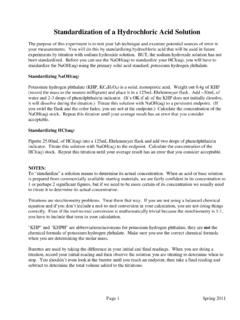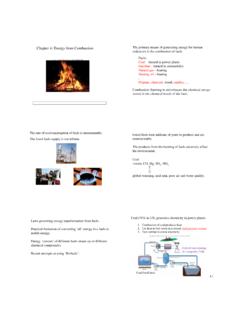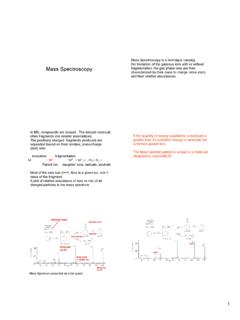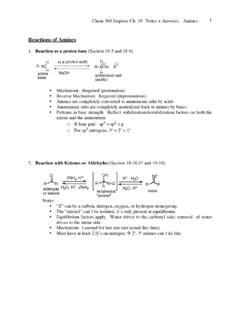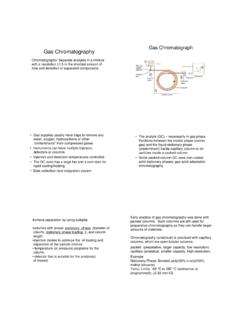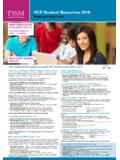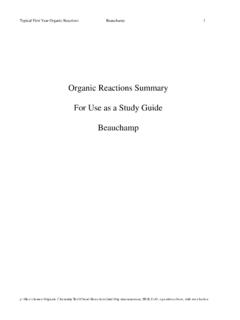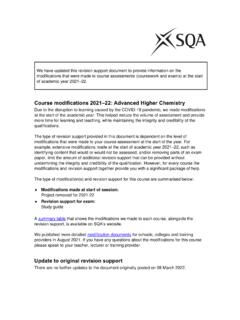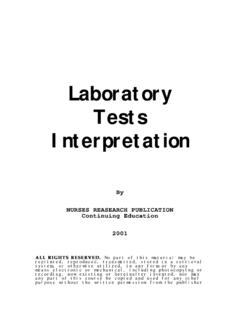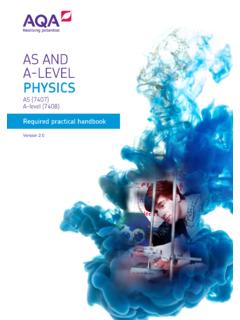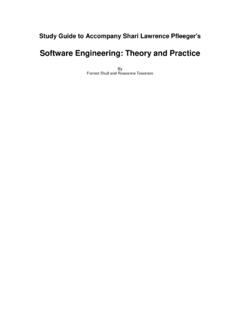Transcription of Preview For ACS-Sandardized Final Exam
1 Chem 360 Jasperse Final Exam Notes. Special Topics 1. Preview For ACS-Sandardized Final Exam 1. 70 Multiple Choice questions. Each has four possible answers. 2. Scoring is based on correct answers. If you don't know the answer, it pays to guess. It especially pays to rule out one or two obviously incorrect answers, even if you aren't sure about which answer is actually correct. 3. Total time will be 2 hours (120 minutes). This means you have 1 minute and 43 seconds per question. Time management is important, but most students complete in time. A more common error than going too slow is to work too fast, hurrying early in the test and not taking enough time to carefully read through the questions and look at all of the answers. I think it is foolish to ever leave before time expires on a multiple choice exam, because the time wasted by leaving early will usually be enough to have rechecked several guess problems and to have eliminated some impossible answers. If time permits, you would like to answer the problem on your own, and then see if your answer matches one of the listed alternatives.
2 4. Calculators are permitted, but there is only one problem that involves arithmetic, and you can probably solve that one by hand. 5. Scores, Percentiles, and Grades The statistical analysis is based on the performance of students from 64 colleges. Shown below are some raw scores with the corresponding national percentiles and the grade that would correspond. Raw Percentile Grade Raw Percentile Grade 10 0 F 35 58 B. 17 5 F 37 64 B. ( should be the statistically average score 39 69 B. of a monkey guessing!) 43 78 B. 20 10 D 44 80 A. 21 12 D 45 81 A. 23 18 D 50 89 A. 24 21 C 55 95 A. 26 28 C 60 98 A. 29 38 C 65 100 A. 30 41 B 70 100 A. 31 45 B. 33 52 B (this is average, slightly less 34 55 B than half of the answers!). 6. Problems are scattered from throughout the book. It is the intent of many of the problems to try to integrate ideas from two or more different chapters. While most things are covered representatively, it is imperative that you be well versed in the general principles of E1, E2, Sn1, Sn2 reactions and of carbonyl compounds.
3 Nomenclature will be covered. Spectroscopy will be covered, but lightly (only about 3. problems, one H-NMR, one C-NMR, one IR.). By my count there are about 45 problems that I would consider very straightforward, comparable to problems you have seen before on tests, book homework, or quizes. There are perhaps 20 problems that I would consider tricky but doable; there are maybe 5 problems that I. would consider very hard, and which may be almost totally unfamiliar to you. Chem 360 Jasperse Final Exam Notes. Special Topics 2. In terms of subject distribution, questions are divided fairly equally between material introduced throughout the year. Nevertheless many fall concepts have been used extensively in spring. If you had total command of your 360 notes and problem sets, you could truly get 45-50. out of 70 right, I think. Study strategy: Study hard, and it will pay off. I would probably work strictly from the notes if my time was I would probably do minimal studying from the text directly, but you would do very well to use the summary sections to help review many of the reactions.
4 To try as many book problems and/or practice tests as possible would help. How much should you study from 350? I would go through all of your 350 notes (and practice tests?) early on, just so that you know how much you remember and how much you have forgotten. My expectation is that a large amount of the old material will now seem more easy than it did originally. The exception to this generalization is in the area of specific reactions. Many of your reactions from fall have not been reused regularly, and will need to be reviewed before the test. What will it Take to Get a Target Grade? A = 80th percentile B = 45th percentile C = 20th percentile D = 10th percentile What will it Take to Get a C? Certain 7 7. 50/50 Guess 20 10. Clueless 43 11. Total 70 28 = 35th percentile = C. What will it Take to Get a B? What will it Take to Get an A? Comfortable B: Comfortable A: Certain 20 20 Certain 35 35. 50/50 Guess 20 10 50/50 Guess 20 10. Clueless 30 7 Clueless 15 4. Total 70 37 = 64th percentile = B Total 70 49 = 88th = A.
5 Summary: The above analysis suggests that if you know only 35 (half) for sure, you will get an A! If you know even 20 for sure, you can get a B! If you know even so much as 10. for sure, you are likely to get a C! While you will not get them all right (a student can totally guess on 15 problems and still get an A!), the key is that you get at least some of them absolutely certain, and can make an educated guess on a reasonable portion of the rest. Special Grade Incentive 90th percentile Special A Even if semester numbers wouldn't justify 80th percentile Special B Even if semester numbers wouldn't justify 70th percentile Special C Even if semester numbers wouldn't justify Score-Handling: I will take your raw score, use national norms to convert it to a percentile score, and convert that back to a letter grade and it's equivalent percentage on one of my normal 100- point tests. I will then multiply that by so that it ends up worth 150 points! Chem 360 Jasperse Final Exam Notes.
6 Special Topics 3. Special Topics for Final Exam: Topics that Frequently Appear on ACS or Standardized Tests, But That I Didn't Cover in Class This Year 1. Epoxides as Electrophiles (Section Representative Problems: ). OR CH3 CH3. H+, HOR Z , Z-H. CH3 O OH. Acid Catalyzed Attack Anion Nucleophile Z. OH SN2 Attack by Weak, Neutral Nucleophile Inversion of Stereochemistry Inversion of Stereochemistry Attack on *More* Subbed End Attack on *Less* Subbed End Because of ring strain, epoxides are relatively reactive toward nucleophilic substitution, in which one of the C-O bonds breaks. Two different substitution profiles: o Strong, anionic nucleophiles SN2 mechanism, followed by a protonation step Types of nucleophiles: Carbon anions: Grignards, enolates, alkyne anions Oxygen anions Stereochemistry: Inversion (if stereochemistry matters). Site of Attack: If Epoxide is unsymmetric, nucleophile attacks the less hindered end o Acid-catalyzed addition of weak, neutral nucleophiles Types of nucleophiles: normally water or alcohol Stereochemistry: Inversion (if stereochemistry matters).
7 Site of Attack: if epoxide is unsymmetric, nucleophile adds to the more hindered end. H+ Me O NaOCH2CH3. EtOH ethanol H2O, H+ O NaOH, H2O. 1. PhMgBr 2. H+. H+ O NaOMe MeOH MeOH. 1. Ph C CNa 2. H+. Chem 360 Jasperse Final Exam Notes. Special Topics 4. 2. Alkyne Alkylations (Section ,7. Representative Problems: ). Strong Base Electrophile R C C H R C C R C C E. -23 (BuLi, LDA, Ka = 10. NaNH2). Overview Alkyne hydrogens are weakly acidic. They can be deprotonated by strong bases to generate carbanions. Like other carbanions (Grignards, enolates .) the anions are strongly nucleophilic and can react with electrophiles Details Acidity o The Ka value for acetylenes is about 10-23, (comparable to a ketone). o Why? Acidity follows hybridization: sp > sp2 > sp3. o Why? The more s character, the closer the electrons are gripped by the positive nucleus. (Reverse of amine basicity ). Base Requirements: o Complete deprotonation is required o Therefore, strong bases are required.
8 O Oxygen anion bases (NaOH, NaOMe ) are too weak. o Nitrogen bases are good: NaNH2 or LDA. o Carbon bases are good: BuLi 3 Electrophiles: Carbonyls (aldehydes and ketones, just as for Grignard and aldol reactions ). Alkyl halides (SN2 reactions). Epoxides 1. NaNH2. Ph C C H. 2. Br 1. BuLi 2. acetone H. 3. H+. 1. NaNH2. H3C C C H. 2. O. 3. H+. Chem 360 Jasperse Final Exam Notes. Special Topics 5. 3. Nucleophilic (Anionic) Aromatic Substitution for a Leaving Group: (Section Representative Problems: ). Cl Z. W W Nucleophile Z. W W. + Cl ANIONIC. Substitution W W. Mechanism: Anionic analog to cationic aromatic substitution Differences: o no ortho/para/meta issues. A halide leaving group must be in the starting material, and the nucleophile must attack at that spot. o Reactivity depends on anion stabilizers at the ortho and para positions. You must have one or more electron withdrawers present. (Unlike cationic aromatic substitution, which benefit from electron donors ).
9 O The withdrawing groups must be ortho and/or para, not meta, otherwise the anionic gets no resonance benefit. o Meta withdrawers don't help much. Leaving groups: Cl, Br, I, even F (which halogen doesn't matter much, because addition is rate determining step, not the elimination). Nucleophiles: NaOH, NaOR, NH3, RNH2, NaNHR (anion or nucleophilic amines). Cl NaOCH3 NO2 CH3CH2NH2 (excess). NO2. Rank the reactivity of the following towards NaOH: Cl Cl Cl Cl Cl O2N NO2 NO2. O2N NO2. NO2 NO2 NO2 E. D. A B C. Common Question formats: A. What is product? B. Rank reactivity (or, which is fastest? Or slowest?). C. Which would be an intermediate or the resonance structure of an intermediate in the following reaction? Chem 360 Jasperse Final Exam Notes. Special Topics 6. 4. Fischer Projections (Section Representative Problems: ). In Fischer projections, atoms attached to horizontal lines are viewed as being in front of the plane (wedged), and atoms attached to vertical lines are viewed as being behind the plane (wedged).
10 B B A D D A E B B E. A D = A C D = = = =. E B B E A D D A. E E. Summary of Fischer Projections and their use: 1. They are most useful for compounds with two or more asymmetric carbon atoms 2. Asymmetric carbons are at the centers of crosses 3. The vertical lines project away from the viewer, the horizontal lines toward the viewer 4. The entire projection can be rotated 180 (but not 90 ) in the plane of the paper without changing its stereochemistry 5. Interchanging any two groups on an asymmetric carbon (for example, those on the horizontal line) inverts the R/S configuration of that chiral carbon. Recognizing Stereochemical Relationships Fischer Projections and their use: 1. One is achiral if there is either a vertical or horizontal plane of symmetry. If no plane, the structure is chiral 2. Meso compounds will have 2 or more chiral centers, but have a horizontal plane of symmetry through a Fischer Projection 3. Two are the same if you can superimpose by sliding one over or by doing a 180 rotation 4.

